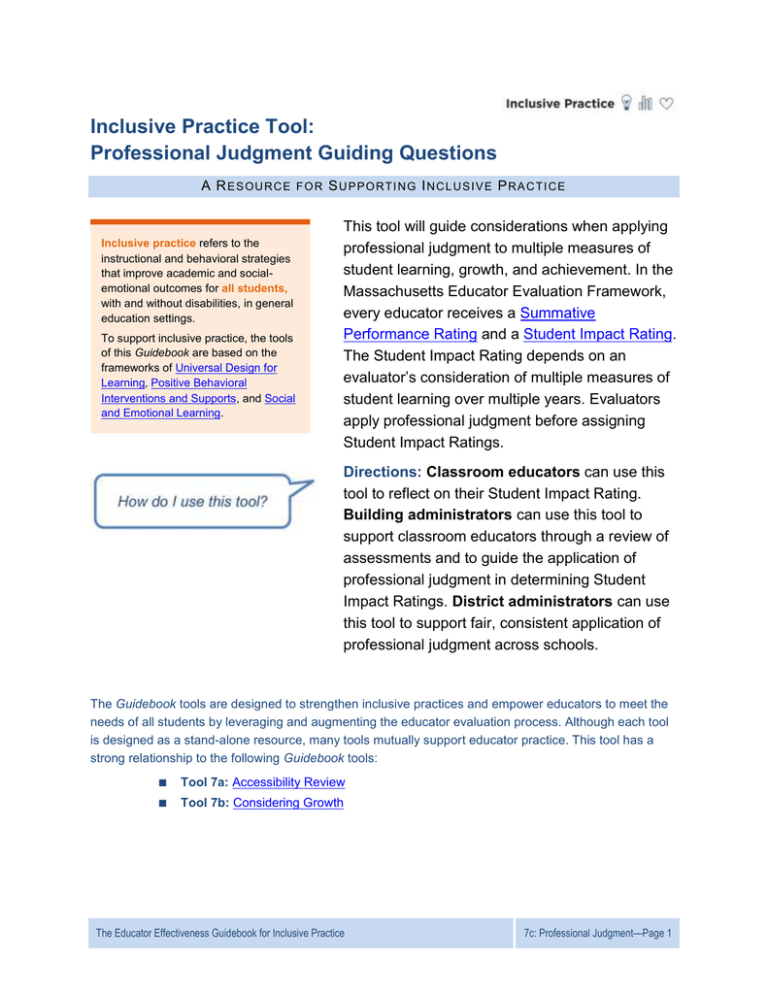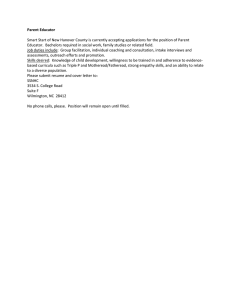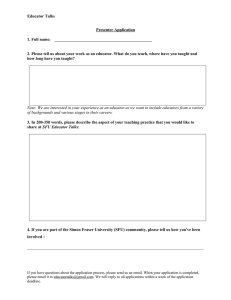7c irprofjudgment
advertisement

Inclusive Practice Tool: Professional Judgment Guiding Questions A R E S O U R C E F O R S U P P O R TI N G I N C L U S I V E P R A C TI C E Definition Inclusive practice refers to the instructional and behavioral strategies that improve academic and socialemotional outcomes for all students, with and without disabilities, in general education settings. To support inclusive practice, the tools of this Guidebook are based on the frameworks of Universal Design for Learning, Positive Behavioral Interventions and Supports, and Social and Emotional Learning. This tool will guide considerations when applying professional judgment to multiple measures of student learning, growth, and achievement. In the Massachusetts Educator Evaluation Framework, every educator receives a Summative Performance Rating and a Student Impact Rating. The Student Impact Rating depends on an evaluator’s consideration of multiple measures of student learning over multiple years. Evaluators apply professional judgment before assigning Student Impact Ratings. Directions: Classroom educators can use this tool to reflect on their Student Impact Rating. Building administrators can use this tool to support classroom educators through a review of assessments and to guide the application of professional judgment in determining Student Impact Ratings. District administrators can use this tool to support fair, consistent application of professional judgment across schools. The Guidebook tools are designed to strengthen inclusive practices and empower educators to meet the needs of all students by leveraging and augmenting the educator evaluation process. Although each tool is designed as a stand-alone resource, many tools mutually support educator practice. This tool has a strong relationship to the following Guidebook tools: ■ Tool 7a: Accessibility Review ■ Tool 7b: Considering Growth The Educator Effectiveness Guidebook for Inclusive Practice │7c: Professional Judgment—Page 1 The following diagram lays out the steps required for the determination of an educator’s Student Impact Rating. This set of Guiding Questions will assist evaluators in assigning Student Impact Ratings to educators after reviewing multiple measures over multiple years. Professional judgment plays a key role in the determination of this rating. Professional judgment involves the use of an evaluator’s specialized knowledge of teaching all learners, including the use of best instructional practices. Evaluators are encouraged to bear in mind an educator’s student population and specific instructional context. Considerations related to a specific measure or a combination of measures may also factor into an evaluator’s determination of an educator’s Student Impact Rating. The use of professional judgment promotes a more holistic and comprehensive analysis of impact, rather than overreliance on one individual data point or rote calculation of impact based on predetermined formulas. These guiding questions can be used in conversation and as personal reflection. Teachers can use this tool for self-reflection and in discussing student growth with an evaluator. Evaluators can use this tool to drive conversation with an educator when discussing the determination of a Student Impact Rating. The Educator Effectiveness Guidebook for Inclusive Practice │7c: Professional Judgment—Page 2 Guiding Questions Student Population What was the makeup of the group of students who completed the measure? Did the student population experience any enrollment issues, such as irregular attendance or late entry? (Note any individual students and the relevant concerns.) Were there any significant home or family issues that might have impacted individual students’ learning? (Note any individual students and the relevant concerns.) Instructional Context What was the educator’s role in planning instruction? What was the educator’s role in classroom instruction? ■ Was the educator the teacher of record for the content? ■ How long was the educator the teacher of record for that class? Considerations of the Measure What measure(s) was(were) used? Was the measure reviewed for accessibility? (See the Inclusive Practice Tool: Accessibility Review.) Does the measure accurately capture growth across diverse student populations? How did similar groups of students score on similar measures in other settings? The Educator Effectiveness Guidebook for Inclusive Practice │7c: Professional Judgment—Page 3





